by Gillian N. Osborne // June 20, 2023
There’s a clean simplicity about Julius von Bismarck’s encompassing, biographical exhibition, ‘When Platitudes Become Form,’ at the Berlinische Galerie. Natural elements have been blown up to life-size and serenely populate the gallery space. The works invite a moment of wonder and a feeling of familiarity. But there is also a sense here that we have fallen down a rabbit hole, that things might not be as they seem.
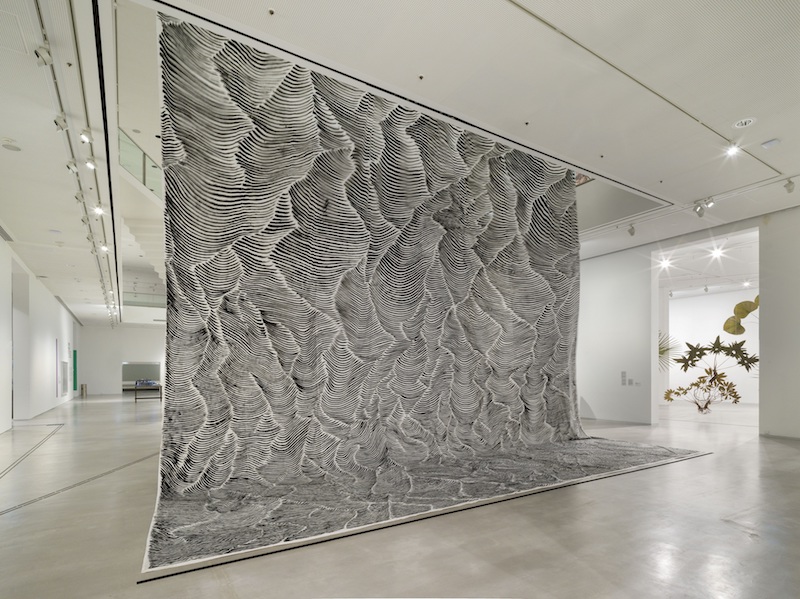
Julius von Bismarck: ‘When Platitudes Become Form,’ 2023, installation view at Berlinische Galerie // Photo © Roman März
The exhibition opens with a shimmering swathe of fabric hanging floor-to-ceiling, swaying back and forth in the breeze of a noisy table fan placed behind it. Painted on the fabric is an enlarged section of choppy sea water, with endless wavy lines tumbling down on one another, taken from a smaller painting, ‘Landscape Painting (Bismarck Sea)’, which is also on display. The waves are life-sized and yet very obviously an enlarged copy; the busy fan apparently mocking any attempt to touch reality through the painted line.
In the next room, large plants and palm trees, which obviously do not originate from Europe, have been pressed flat and dried. Backed with precision-cut aluminium, they retain their impressive size and shape, although they are flat. The trees hang in the space like a strange fantasy forest, evoking the two-dimensional drawings of a children’s encyclopaedia. The effect is like an offering, as if the plants are specimens or bounty for our delectation.
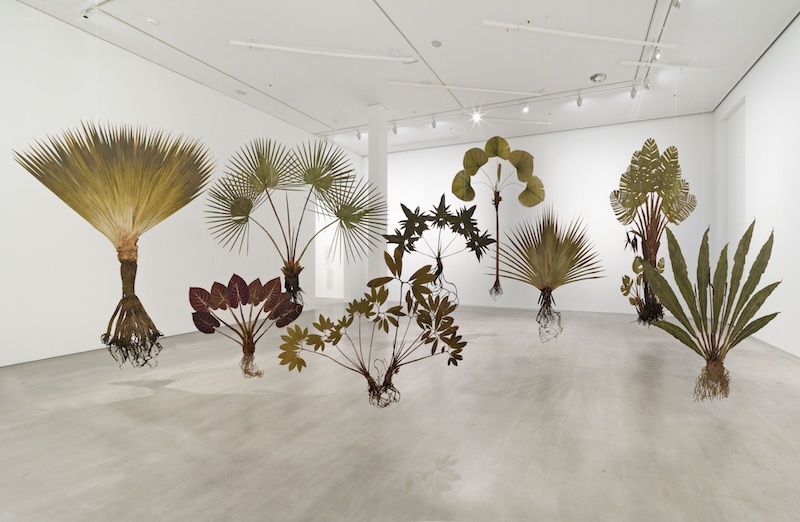
Julius von Bismarck: ‘When Platitudes Become Form,’ 2023, installation view at Berlinische Galerie // Photo © Roman März
Following the marked walkways, in the next room we encounter two gigantic push puppets—those wooden animal toys that, when pushed from underneath, collapse into a heap of limbs and feet, only to pop up again when the pressure is released. Von Bismarck has created automated, large-scale versions of the original: a giraffe, and another with a copy of a statue of his ancestor, Otto von Bismarck, the first Chancellor of Germany, green in a nod to the patina that presumably covers the real, copper statue it seeks to replicate. On the day I visited the sculptures stood keeled over in half-composure, their strings exposed, as the automation had failed. Von Bismarck not only plays with childhood associations here, he really does make us feel small again in relation to these images and objects. The works provoke a flash of delight in the familiar but long forgotten, but also in the sheer beauty of the objects themselves.
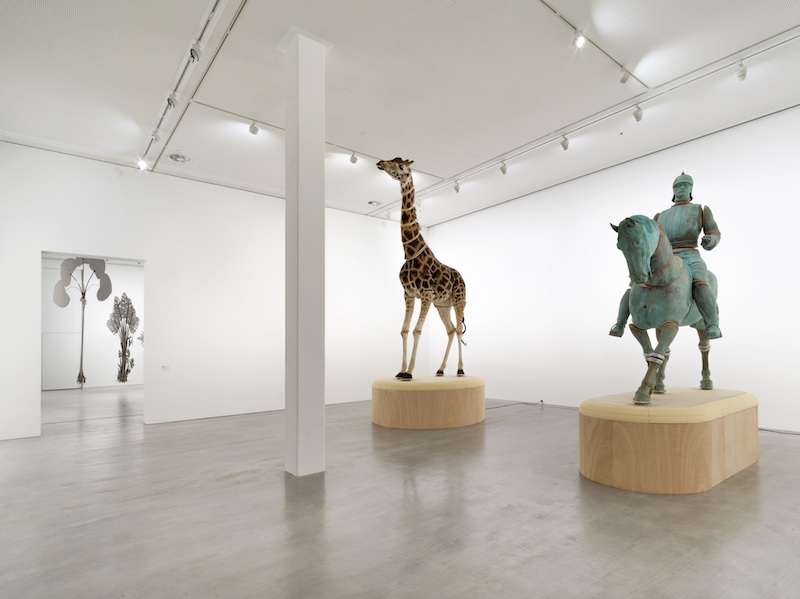
Julius von Bismarck: ‘When Platitudes Become Form,’ 2023, installation view at Berlinische Galerie // Photo © Roman März
But this is a trap. The waves of the drawing are life-sized, but they fail to fulfil their promise of being anything close to life-like. The hanging, encyclopaedic plants are dead and dry. The giraffe wears a real giraffe skin, but bears no resemblance to a real giraffe. In making these toys and images to scale, von Bismarck forces a comparison to real, living animals and plants. And we quickly find the articles wanting. We start to see how real natural phenomena from other continents have been taken out of context by Europeans and turned into simple, childish motifs, trivialised and exoticized. We have treated nature as “ours to play with,” so to speak, riding roughshod over cultural context, leaving us with shallow copies of the objects in question.
This realisation is achieved in part through the titles of the works. The ludicrous fact of there being a Bismarck Sea north of Papua New Guinea points us directly to German colonialism, without much more information being necessary. Likewise the “official” names included in the titles of the flattened plants (‘Bismarckia nobilis’) reveal the European colonial urge to stake ownership and disregard any previous context. But it’s also achieved through the provocation of individual emotions. The initial moment of joyful delight that these works produce quickly fades when we realise what’s really going on. Our capacity to delight in decontextualized, aestheticized versions of real natural phenomena becomes instead a source of shame.
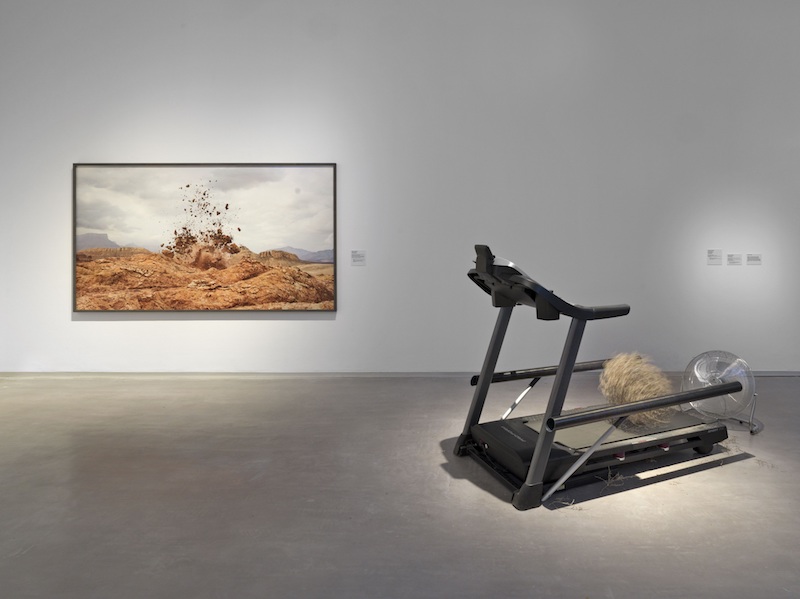
Julius von Bismarck: ‘When Platitudes Become Form,’ 2023, installation view at Berlinische Galerie // Photo © Roman März
Other works in the exhibition similarly play with questions of reality and the human tendency to appropriate nature. ‘Geh aus mein Herz’ shows an autumn forest from above, the branches swaying violently in the wind as leaves fall to the ground. Like birds we watch the scene from above, far away from human activity. And yet we slowly learn that the wind is caused by a camera-carrying drone, that witnessing this scene depends on our destroying it, and a feeling of dread sets in. For ‘I am Afraid I Must Ask You To Leave’ (2018, with Julien Charrière), natural monuments were painstakingly recreated in life-size and then blown up, and videos of the explosions leaked to the media. The resulting furore was documented and is also on display in the exhibition. It’s clear that these works pose questions about the human tendency to exercise ownership over natural phenomena and how successful such a project can ever be.
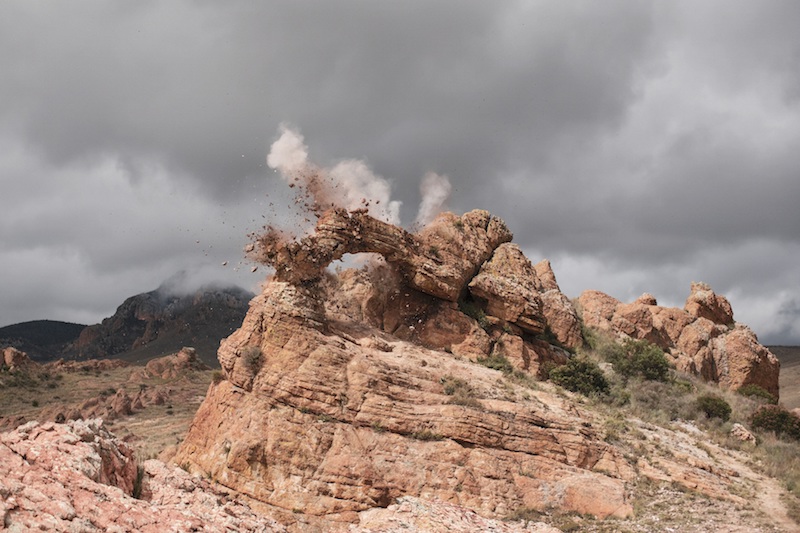
Julius von Bismarck and Julian Charrière: ‘Grand Staircase Escalante, We Must Ask You to Leave (mountain view drive),’ 2018 // © Julius von Bismarck / VG Bild-Kunst, Bonn 2023
Von Bismarck is explicitly investigating Germany’s colonial past here, perhaps even trying to publicly make amends for his own family’s involvement in the colonial project. Whether drawing attention to historical facts really makes a difference to people still suffering from the effects of colonialism today isn’t clear. And yet the works on display here do something else, something that might indeed be worthwhile. They question the accuracy of Eurocentric imagery of other continents by asking visitors to think about the nature of reality and appearances. And they interrupt the tendency to delight in the unfamiliar, to appropriate and decontextualize, spoiling our enjoyment by revealing its destructiveness. As our delight turns to shame, we are able to self-reflect on the processes within us and see how we have participated in a a process of exoticisation. This might make all the difference in a world that is slowly coming to terms with its historical responsibilities.
Exhibition Info
Berlinische Galerie
Julius von Bismarck: ‘When Platitudes Become Form’
Exhibition: May 26–Aug. 14, 2023
berlinischegalerie.de
Alte Jakobstraße 124–128, 10969 Berlin, click here for map





















